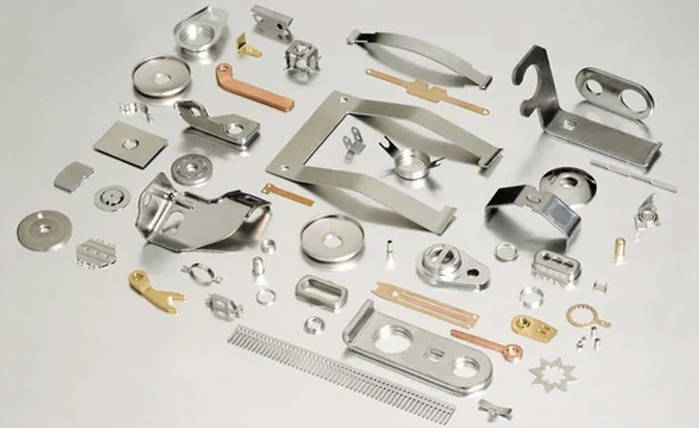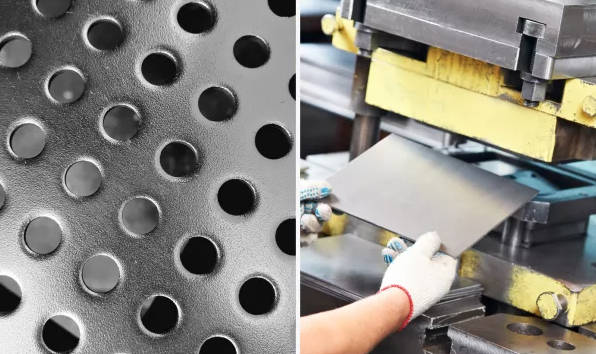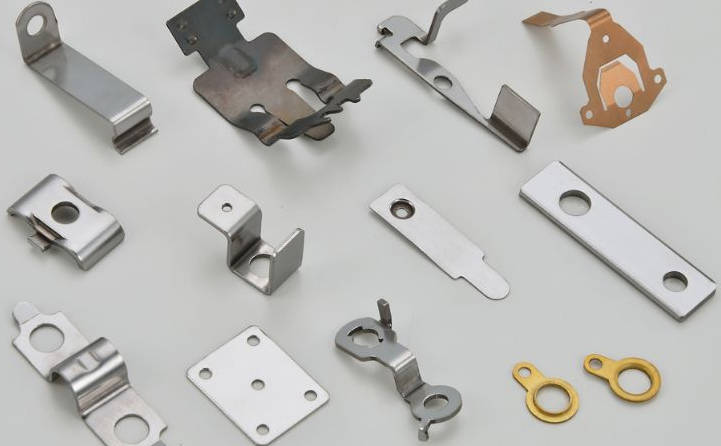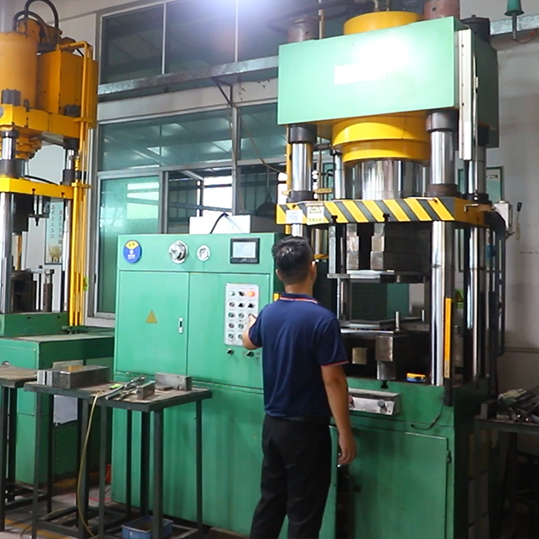The metal stamping process is a high-speed, cost-effective manufacturing method for producing large quantities of identical metal parts by pressing or punching sheet metal with a die. This process involves various techniques, including blanking, bending, coining, and flanging, to shape a flat metal sheet into a desired form. For engineers, understanding the nuances of stamping is crucial for designing manufacturable, functional, and budget-friendly components.
Whether you’re new to designing for stamping or a seasoned professional looking for a refresher, you likely have questions. This comprehensive guide answers the 20 most frequently asked questions engineers have about the metal stamping process, covering everything from fundamental concepts and material selection to design for manufacturability (DFM), tooling, and cost analysis.

Table of Contents
- Part 1: The Fundamentals of Metal Stamping
- Part 2: Material Selection and Properties
- Part 3: Design for Manufacturability (DFM)
- Part 4: Tooling and Dies
- Part 5: Production, Quality, and Cost
- Conclusion: Partnering for Stamping Success
Part 1: The Fundamentals of Metal Stamping
Before diving into complex design and material choices, it’s essential to have a solid grasp of the core concepts of the stamping process. This section covers the foundational questions engineers often have.
1. What exactly is the metal stamping process?
Metal stamping, also known as pressing, is a cold-forming manufacturing process used to shape flat sheet metal into specific forms. The process involves placing a sheet of metal, either in coil or blank form, into a stamping press. Inside the press, a tool and die surface form the metal into the desired shape. This is a net-shape process, meaning the final part is produced with minimal material waste. The press applies immense force to the die, which performs operations like blanking, piercing, bending, forming, coining, and drawing to create the component’s features.
2. What are the main types of metal stamping?
While the core concept is the same, stamping processes are categorized based on the tooling and production method. The three most common types are:
- Progressive Die Stamping: In this method, a coil of metal is fed through a press that contains a single die with multiple stations. Each station performs one or more operations, and as the strip of metal *progresses* through the die, the part is gradually formed. This is ideal for high-volume production of complex parts due to its high speed and low per-part labor cost.
- Transfer Die Stamping: Similar to progressive die, this process uses multiple stations. However, the part is separated from the metal strip early on and is mechanically transferred from one station to the next using “fingers” or another transfer mechanism. This is advantageous for larger parts that cannot be easily carried on a carrier strip, such as deep-drawn components or structural frames.
- Compound Die Stamping: In a single press stroke, a compound die performs multiple cuts or punches. For example, it can punch out the outer perimeter and an inner hole simultaneously. This method is known for high accuracy and excellent feature-to-feature concentricity but is generally slower than progressive stamping and limited to simpler, flatter parts.
3. What’s the difference between stamping, forming, and deep drawing?
These terms are often used interchangeably, but they refer to distinct operations within the broader category of sheet metal manufacturing:
- Stamping: This is the umbrella term that encompasses the entire process, including cutting (blanking, piercing) and forming operations.
- Forming: This specifically refers to any operation that changes the shape of the metal along a curved axis *without* intentionally changing its thickness. Bending and flanging are common forming operations.
- Deep Drawing: This is a more specialized forming process where a sheet metal blank is radially drawn into a forming die by a punch. It’s used to create parts where the depth is significantly greater than the diameter. Think of a soda can or a kitchen sink. The key characteristic is the plastic flow and stretching of the material into a cup-like shape.
4. Which industries rely heavily on metal stamping?
Metal stamping is a foundational manufacturing process used across nearly every major industry due to its versatility, speed, and cost-effectiveness. Key sectors include:
- Automotive: For body panels, brackets, engine components, and chassis parts.
- Aerospace: For structural components, enclosures, and specialized fasteners.
- Electronics: For connectors, shielding, terminals, and heat sinks.
- Medical Devices: For surgical instruments, implants, and diagnostic equipment components.
- Appliances: For housings, frames, and internal components of washers, dryers, and refrigerators.
- Industrial & Construction: For hardware, fasteners, brackets, and structural supports.
Part 2: Material Selection and Properties
The success of a stamped part begins with the right material. An engineer’s choice of metal directly impacts performance, cost, and manufacturability.
5. What materials are suitable for metal stamping?
A wide range of metals can be stamped, provided they have sufficient ductility to be formed without fracturing. Common choices include:
- Carbon Steels (Low, Medium, and High Carbon)
- Stainless Steels (e.g., 301, 304, 316, 410)
- Aluminum (e.g., 1100, 3003, 5052, 6061)
- Copper and its Alloys (Brass, Bronze, Beryllium Copper)
- High-Strength, Low-Alloy Steels (HSLA)
- Nickel and Specialty Alloys (Inconel®, Monel®, Hastelloy®)
6. How do I choose the right material for my application?
Selecting the optimal material requires balancing several key factors:
- Formability: Does the material have the ductility to achieve the part’s geometry without cracking? Materials with higher elongation values are generally more formable.
- Strength Requirements: Will the part be under load? Consider the material’s yield strength and tensile strength.
- Corrosion Resistance: Will the part be exposed to moisture or harsh chemicals? Stainless steel, aluminum, or plated carbon steel might be necessary.
- Cost: Raw material cost is a significant driver. Balance performance needs with budget constraints. For example, cold-rolled steel is often a cost-effective choice for general applications.
- Weight: For applications in automotive or aerospace, lightweight materials like aluminum or high-strength steels are often preferred.
- Conductivity: For electrical components, copper and its alloys are the primary choice due to their excellent electrical and thermal conductivity.
7. How does material thickness and temper affect the stamping process?
Material thickness and temper (hardness) are critical inputs for the stamping process. They directly influence:
- Tonnage Requirement: Thicker and harder materials require a press with a higher tonnage (force) to cut and form them.
- Tooling Design and Wear: Dies used for thicker or harder materials must be more robust and will experience faster wear, potentially increasing maintenance costs.
- Bend Radius: Harder tempers and thicker materials require a larger minimum bend radius to prevent cracking at the bend.
- Springback: Harder materials exhibit more *springback* (the tendency of the material to return to its original shape after forming), which must be compensated for in the tool design through over-bending.
8. What is the importance of grain direction in metal stamping?
During the rolling process, the metal’s crystalline structure becomes elongated in the direction of rolling, creating a “grain.” This directionality affects the material’s mechanical properties. Bending a part *parallel* to the grain is more likely to cause cracking, especially on tight radii. Bending *perpendicular* to the grain is much safer and results in a stronger bend. For complex parts with bends in multiple directions, it’s best to orient the bends at a 45-degree angle to the grain. As an engineer, it’s crucial to note any critical bend features on your drawing so the stamper can orient the part on the coil strip appropriately to ensure part integrity.
Part 3: Design for Manufacturability (DFM)
Designing a part with the stamping process in mind is the single most effective way to reduce costs and improve quality. This is known as Design for Manufacturability (DFM).
9. What are the most critical design considerations (DFM) for stamped parts?
Key DFM principles for stamping include simplifying geometry, designing realistic tolerances, and understanding the process’s limitations. Focus on:
- Bend Radii: Avoid sharp corners; specify generous radii.
- Hole Placement: Keep holes away from bends and edges.
- Tolerances: Don’t over-tolerance. Specify tight tolerances only where functionally necessary.
- Feature Orientation: Consider how features can be formed efficiently within a progressive die.
- Material Selection: Choose a material that can achieve the geometry without requiring exotic (and expensive) forming techniques.
10. How do you determine the minimum bend radius?
The minimum inside bend radius is the smallest radius you can form in a material without cracking or excessive thinning on the outer surface. A general rule of thumb is that the minimum inside bend radius should be at least equal to the material thickness. However, this varies significantly based on material type, temper, and the bend’s orientation to the grain. Softer materials like annealed aluminum can tolerate a 0T radius (a sharp corner), while hard materials like full-hard stainless steel may require a radius of 3T or more. Always consult a stamping expert or material data sheets for specific recommendations.
11. What are the guidelines for hole sizes and spacing?
Following established guidelines for holes prevents punch breakage, part distortion, and high tooling maintenance. Key rules include:
- Minimum Hole Diameter: The diameter of a pierced hole should ideally be no smaller than the material thickness. For harder materials, this can increase to 2x the material thickness.
- Hole to Edge Spacing: The distance from the edge of a hole to the edge of the part should be at least 1.5x to 2x the material thickness.
- Hole to Hole Spacing: The distance between the edges of two adjacent holes should be at least 2x the material thickness.
- Hole to Bend Spacing: The distance from the edge of a hole to the start of a bend tangent should be at least 2.5x the material thickness plus the bend radius to prevent the hole from distorting into an oval shape.
12. How is springback managed and compensated for in part design?
Springback is the elastic recovery of material after a forming operation. If you bend a piece of metal to 90 degrees and release it, it might spring back to 92 degrees. This phenomenon is more pronounced in high-strength materials and thinner gauges. Stampers manage this in several ways:
- Overbending: The tool is designed to bend the material past the target angle (e.g., to 88 degrees) so it springs back to the desired 90 degrees.
- Coining: The die applies localized compressive stress at the bend radius to “set” the material and reduce its tendency to spring back.
- Bottoming or Staking: The punch presses the material with extreme force at the bottom of the stroke, coining the entire bend area to lock in the angle.
As a designer, you don’t typically design the compensation yourself. However, you should be aware that tight angle tolerances may require more complex and expensive tooling to manage springback effectively.
Part 4: Tooling and Dies
The die is the heart of the stamping process. Understanding tooling is key to understanding lead times, costs, and production capabilities.
13. What is a stamping die (tooling) and how does it work?
A stamping die is a specialized, custom-built tool that cuts and forms sheet metal into a specific part. It consists of two halves: the upper die (punch), which attaches to the press ram, and the lower die (die block), which is secured to the press bed. As the press cycles, the punch descends into the die block, and the sheet metal between them is sheared, bent, or formed. A complex progressive die can be made of hundreds of precision-machined components, including punches, die buttons, guide pins, springs, and strippers, all working in unison to produce the final part.
14. What is the difference between hard tooling and soft tooling?
The main difference lies in the tool’s construction, durability, and intended production volume.
| Feature | Soft Tooling | Hard Tooling |
|---|---|---|
| Material | Softer tool steels (e.g., A2, D2) or even non-traditional methods. | Hardened, high-performance tool steels (e.g., M2, carbide inserts). |
| Production Volume | Low-volume, prototypes, short runs (hundreds to thousands). | High-volume, mass production (hundreds of thousands to millions). |
| Lead Time | Shorter (weeks). | Longer (months). |
| Upfront Cost | Lower. | Significantly higher. |
| Per-Part Cost | Higher (slower cycle times, more labor). | Lower (high-speed automation). |
| Tool Life | Shorter. | Very long, often guaranteed for a specific number of hits. |
15. How long does stamping tooling typically last (tool life)?
Tool life depends entirely on the type of tooling, the material being stamped, part complexity, and maintenance. Soft tooling may last for a few thousand to tens of thousands of cycles. A high-quality progressive hard tool, on the other hand, is often designed to last for millions of cycles. These tools are built with wear-resistant materials like carbide at critical points and are subject to a rigorous preventative maintenance schedule where cutting edges are sharpened and components are replaced before they fail.
16. Who owns the tooling?
In most cases, the customer owns the tooling. The customer pays a one-time, non-recurring engineering (NRE) charge for the design and construction of the die. The stamping supplier then stores, maintains, and runs the tool on the customer’s behalf. This arrangement ensures the customer has control over their intellectual property and production asset. The terms of ownership, maintenance, and storage should always be clearly defined in the quotation and purchase order.
Part 5: Production, Quality, and Cost
Ultimately, an engineer’s goal is to get a quality part on time and on budget. This section addresses the practical aspects of production.
17. What are the primary cost drivers in metal stamping?
The cost of a stamped part is a combination of four main factors:
- Tooling Cost (NRE): The upfront investment to build the die. More complex parts and higher production volumes require more expensive, durable tooling. This is amortized over the life of the project.
- Material Cost: The price of the raw material (steel, aluminum, etc.) and the amount of scrap generated. Efficient nesting of parts on the coil strip is crucial to minimize waste.
- Press Time (Burden Rate): The cost per hour to run the stamping press, which includes labor, electricity, maintenance, and overhead. Faster, more efficient processes like progressive stamping reduce this cost per part.
- Secondary Operations: Any post-stamping processes like deburring, plating, heat treating, or assembly add to the final part cost.
18. What tolerances can be realistically achieved with stamping?
Standard commercial tolerances for stamped parts are often in the range of +/- 0.005″ to +/- 0.015″ (+/- 0.13mm to +/- 0.38mm). However, much tighter tolerances are achievable. With precision tooling, a well-maintained press, and robust quality control, it’s possible to hold tolerances of +/- 0.001″ to +/- 0.003″ (+/- 0.025mm to +/- 0.076mm) on specific features. It is crucial to remember that every tightened tolerance adds cost and complexity to the tool. Engineers should only specify tight tolerances on functionally critical dimensions.
19. What are common secondary operations for stamped parts?
A stamped part is often not complete when it comes off the press. It may require additional processing to meet final specifications. Common secondary operations include:
- Deburring: Removing the sharp burr left on the edge of the part from the cutting process, using methods like tumbling, vibratory finishing, or belt sanding.
- Plating & Finishing: Applying a coating for corrosion resistance or cosmetic appearance, such as zinc plating, anodizing, powder coating, or e-coating.
- Heat Treating: Altering the mechanical properties of the part, such as increasing its hardness and strength through processes like case hardening or through-hardening.
- Machining: Creating features that are not possible or economical to produce in the stamping die, such as tapped holes or precision-reamed bores.
- Assembly: Joining stamped parts to other components through welding, riveting, or staking.
20. What information is needed to get an accurate quote for a stamped part?
To provide a fast and accurate quote, a stamping supplier needs a complete information package. The more detail you provide, the better. Be sure to include:
- A 3D CAD model and a 2D drawing: The model shows the geometry, while the drawing defines dimensions, tolerances, materials, and any special notes.
- Material specifications: Include the type of material, grade, thickness, and temper.
- Tolerances: Clearly define critical dimensions and their required tolerances.
- Annual usage volume (EAU): This is essential for determining the type of tooling (soft vs. hard) and calculating per-part pricing.
- Finishing and secondary operation requirements: Specify any plating, heat treating, or assembly needed.
- Packaging requirements: Note any special packaging needs to protect sensitive parts during shipment.
Conclusion: Partnering for Stamping Success
Understanding the answers to these 20 questions provides a strong foundation for any engineer involved in designing sheet metal components. The metal stamping process is a powerful combination of science and art, offering unparalleled speed and efficiency for mass production. The key to success lies in early collaboration between the design engineer and the stamping supplier. By leveraging their manufacturing expertise during the design phase, you can optimize your part for cost, quality, and long-term performance.
metal stamping, stamping process, progressive die stamping, sheet metal forming, stamping die, stamping faqs, DFM for stamping, metal stamping materials, metal stamping tolerances, deep drawing, springback, stamping tooling, engineering questions stamping





